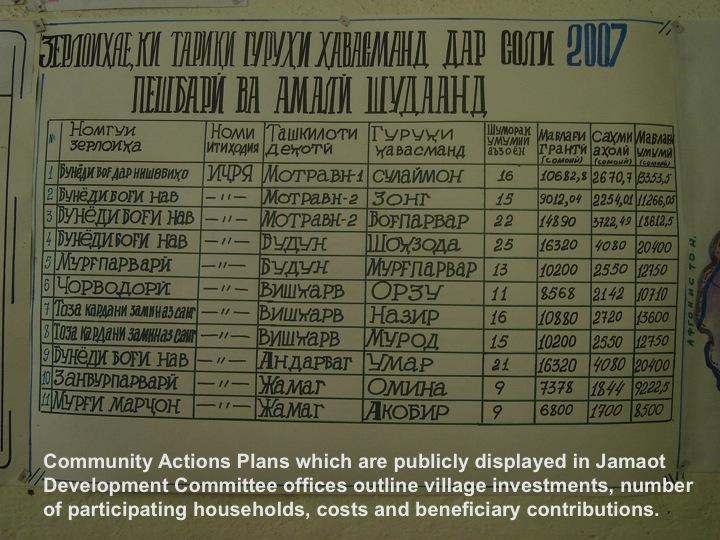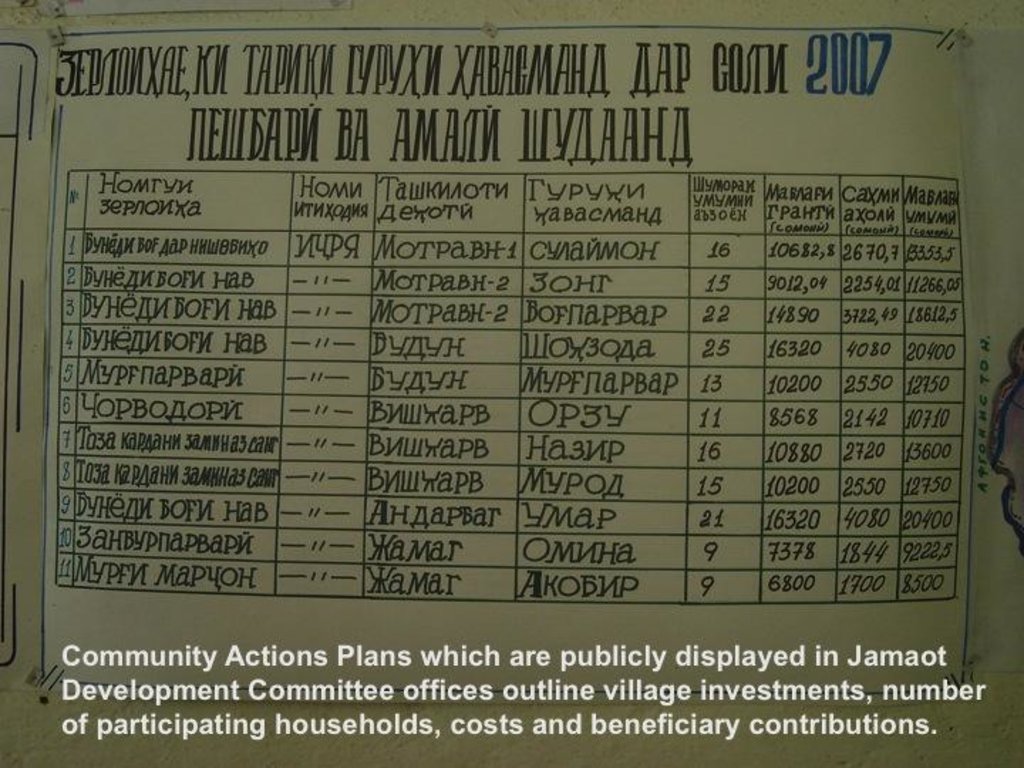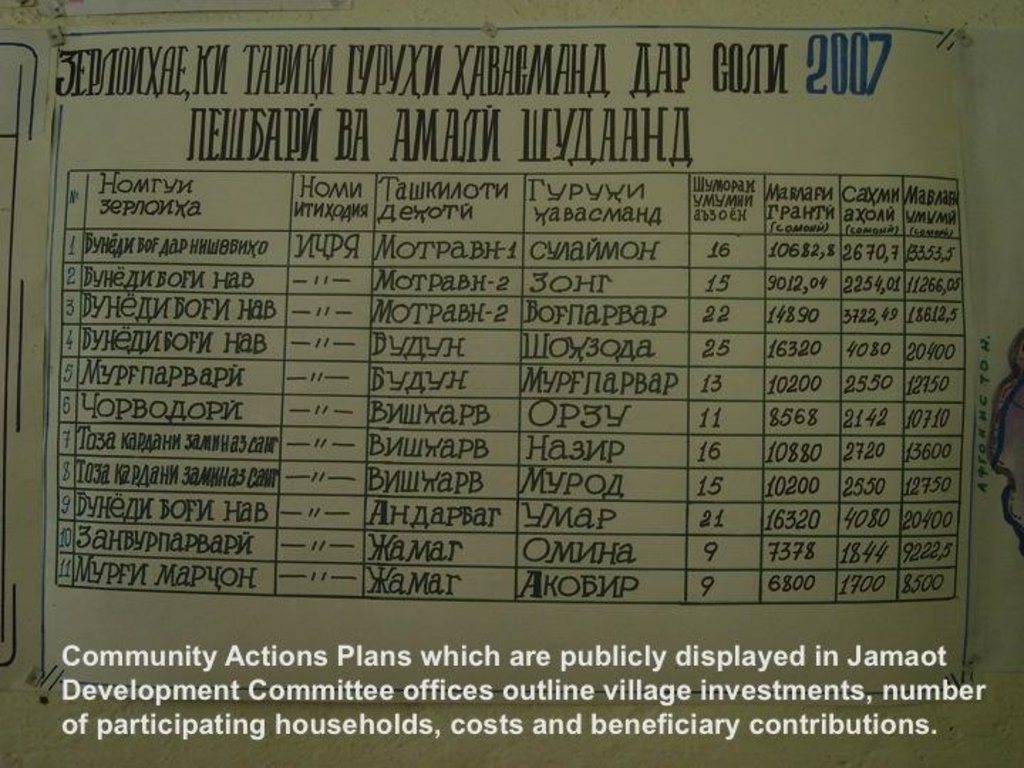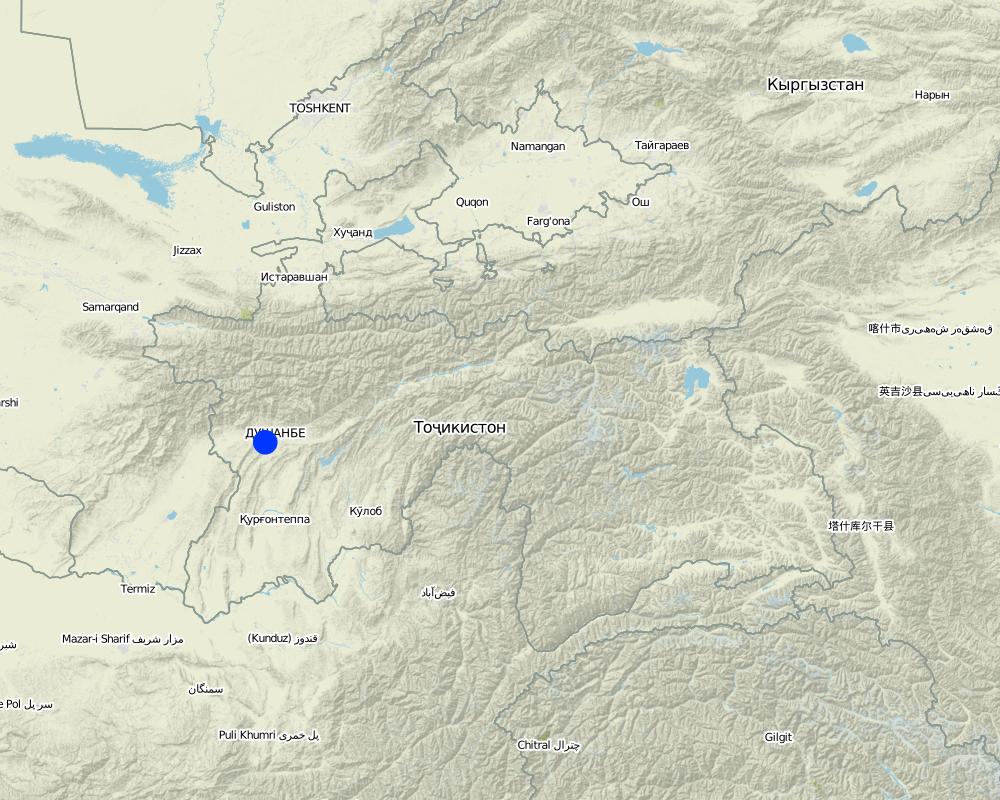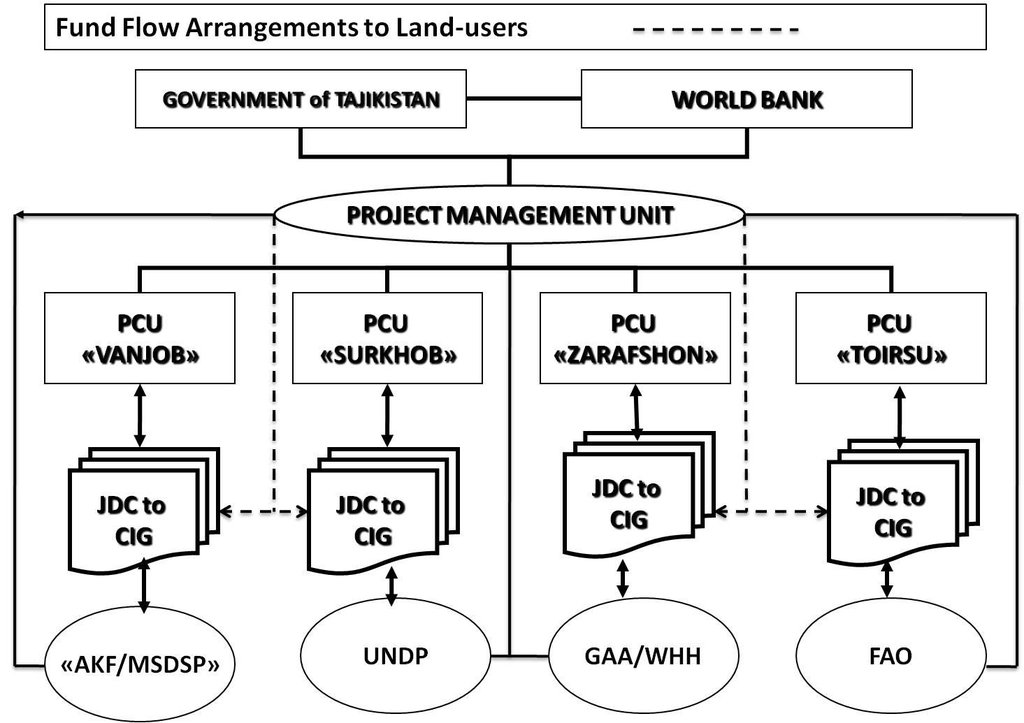SLM small grant allocation mechanisms [طاجيكستان]
- تاريخ الإنشاء:
- تحديث:
- جامع المعلومات: Nandita Jain
- المحرر: –
- المُراجع: David Streiff
approaches_2453 - طاجيكستان
عرض الأقسام
توسيع الكل طي الكل1. معلومات عامة
1.2 تفاصيل الاتصال بالأشخاص الرئيسيين لمصدر المعلومات والمؤسسات المعنية بتقييم وتوثيق النهج
متخصص في الإدارة المستدامة للأراضي:
Mott Jessica
World Bank
اسم المؤسسة (المؤسسات) التي سهلت توثيق/تقييم النهج (إذا كان ذلك على صلة)
World Bank (World Bank) - الولايات المتحدة1.3 الشروط المتعلقة باستخدام البيانات الموثقة من خلال WOCAT
يوافق جامع المعلومات والشخص (لاشخاص) الرئيسي لمصدر المعلومات على الشروط المتعلقة باستخدام البيانات الموثقة من خلال WOCAT:
نعم
2. وصف نهج الإدارة المستدامة للأراضي
2.1 وصف موجز للنهج
Mechanisms to facilitate participatory decision-making about grant allocation among land users and improve transparency and accountability in flow of funds to beneficiaries in small-grant programmes for SLM.
2.2 وصف تفصيلي للنهج
وصف تفصيلي للنهج:
Aims / objectives: As part of the Community Agriculture & Watershed Management Project (CAWMP), this approach helped beneficiaries and project partners allocate grants and manage the flow of funding while promoting fairness, transparency, and ownership. It facilitated appropriate SLM choices across the highly variable agricultural, climatic and geographic conditions. Almost 4000 rural investments including SLM technologies were implemented, resulting in over 96,000ha under improved land management practices and benefits for more than 43,000 households in Tajikistan’s uplands.
Methods: This approach set a fixed budget per village, limited the grant value received per household as well as the total size of any one grant, required minimum levels of beneficiary contributions, and provided grant money to beneficiaries, enabling them to purchase the inputs.
Stages of implementation: Fixed village budget: In their Community Action Plans (CAP) villages assigned priorities to grants within a set budget amount for the entire village. Project guidelines specified a formula for this budget based on amounts per investment type per household excluding beneficiary contributions ($30/household for farm productivity, $74/household for land management, and $30/household for rural infrastructure). The number of households in a village multiplied by these per-household-amounts determined the overall size of the grant funding for that village. Grant allocation limits. The villages were informed of their overall budget as well as the household limits for each category. They chose investments for groups of households (Common Interest Groups, CIGs) and allocated grant funds to subprojects accordingly. The household limits ensured that collectively at least 50% of the families would benefit directly. In practice, about 75%, of a total of about 57000 households in the project sites participated in the farm productivity and land resource management investments, and 60% in rural infrastructure investments. Grant size. Except in a few cases requiring special approval, the Project-financed grants for each subproject were lower than US$5,000, which reduced risks of the funds being used for purposes for unrelated to the Project. Beneficiary Contribution. Beneficiaries were required to contribute a minimum of 25% of the grant amount in labor, materials or cash which increased their stake in the investment, thereby strengthening ownership and sustainability. At least 5% of the grant amount for rural infrastructure had to be contributed in cash at the start in order to demonstrate financial sustainability.
Role of stakeholders: Fund flow. Once a grant proposal was approved, the PMU transferred the grant amount to the local savings bank according to the schedule specified in the agreement between Jamoat Development Committee (JDC) and CIGs. The JDC accountant transferred the funds fromthe bank to the CIGs. The CIGs then had the responsibility for purchasing inputs, which created an incentive for selecting cost-effective inputs.
2.3 صور عن النهج
2.5 البلد/المنطقة/المواقع التي تم تطبيق النهج فيها
البلد:
طاجيكستان
المنطقة/الولاية/المحافظة:
Sughd, Region of Republican Subordination, Khatlon, GBAO
مزيد من التفاصيل حول الموقع:
Jirgital, Tajikibad, Vanj, Aini, Matcha, Penjikent, Danghara
التعليقات:
The Community Agriculture and Watershed Management Project was implemented in four project sites/watersheds - Surkhob, Toirsu, Vanjob and Zarafshan - which included 7 districts/raions and 39 sub-districts/jamoats. The total catchment area was 35,000km2. Total arable, farm and pasture land was approximately 319,500ha.
Map
×2.6 تواريخ بدء وإنهاء تنفيذ النهج
أشر إلى سنة البدء:
2005
سنة الإنهاء (إذا لم يعد النهج مطبقًا):
2012
2.7 نوع النهج
- قائم على مشروع/برنامج
2.8 الغايات/الأهداف الرئيسية للنهج
The Approach focused mainly on other activities than SLM (small grant programmes, participatory decision-making, village-level, fixed budgets, fund flow arrangements, farmer groups)
Practical and feasible mechanisms for beneficiaries and project partners for: a) grant allocation and fund flow that promote fairness, transparency, and beneficiary ownership in the context of Tajikistan; and b) facilitate appropriate SLM choices across the highly variable agro-climatic and other geographic conditions of the country.
The SLM Approach addressed the following problems: Prior to CAWMP, no practical incentives in donor-funded grant programmes for beneficiaries to consider how to optimise returns according to local conditions. Limited choice of technologies, elite capture of resources, requests for large grants and absence of beneficiary contributions led to inappropriate investments for local agro-climatic conditions, and poor returns and investments not maintained in subsequent years.
2.9 الظروف التي تمكن أو تعيق تنفيذ التقنية/التقنيات المطبقة بموجب النهج
المعايير والقيم الاجتماعية /الثقافية/ الدينية
- معيق
Grant allocations vulnerable to elite capture and/or political influence. Time taken to address such pressures.
Treatment through the SLM Approach: Participatory planning and full disclosure at the start of planning to villagers of available funding and its calculation at village and household levels.
توفر/الوصول إلى الموارد والخدمات المالية
- معيق
Beneficiary dependence on donors/implementing agencies since resources given were “in-kind” and not cash.
Treatment through the SLM Approach: Adopted “good practice” from other countries with arrangements for direct cash transfers to beneficiaries organised as groups of farmers who then had responsibility for managing financial resources and procurement for chosen investments.
الإطار المؤسساتي
- معيق
Lack of active participation by beneficiaries in decision-making over grant amounts and choice of investments.
Treatment through the SLM Approach: Innovative rules about grant allocations enabling villagers to consider various options of grant amounts and types of investments in a participatory manner, taking into account their local conditions.
المعرفة حول الإدارة المستدامة للأراضي، والوصول إلى الدعم الفني
- معيق
Participatory planning processes lacked consideration of multiple factors, e.g., grant amount, choice of technologies, local context, beneficiary contribution, selection of beneficiaries.
Treatment through the SLM Approach: Inclusion of participatory rural appraisal, formulae and rules governing grant allocations in CAP preparation. First 3 proposals for each investment category in project sites reviewed to assess understanding of guidelines. Random review thereafter.
3. المشاركة وأدوار الأطراف المعنية
3.1 أصحاب المصلحة المعنيون بالنهج وأدوارهم
- مستخدمو الأراضي المحليون/المجتمعات المحلية
CIGs (Groups of households)
Local cultural and social conditions determined the extent to which women took part in the grant allocation decision-making, and as members of CIGs managing small grant funds. In some more remote communities, it was not generally acceptable for women to be active participants. In other areas, women only CIGs were formed.
Marginal groups within a generally poor upland rural population participated in grant allocation decisions and as CIG members in managing small grant funds. In some villages, vulnerable and poor households were targeted as priority recipients of grants through the allocation mechanism.
Participated grant allocation decision making and fund management
- منظمة غير حكومية
JDCs – locally registered NGOs
JDCs managed fund transfers to CIGs based based on formal agreements
- الحكومة الوطنية (المخططون، صانعو القرار)
Project Management Unit
إذا كان هناك العديد من الأطراف المعنية، قم بالإشارة إلى الوكالة الرائدة:
Project Management Unit and CIGs
3.2 انخراط مستخدمي الأراضي المحليين/المجتمعات المحلية في المراحل المختلفة للنهج
| انخراط مستخدمي الأراضي المحليين/المجتمعات المحلية | حدد من شارك وصف الأنشطة | |
|---|---|---|
| المبادرة/التحفيز | غير موجود | |
| التخطيط | سلبي | Potential beneficiaries consulted for social assessment conducted during project design which then influenced project approaches. |
| التنفيذ | تفاعلي | Villagers made grant allocation decisions. CIGs managed grant funds and bought inputs. |
| الرصد/التقييم | تفاعلي | JDCs release grant funds according to benchmarks in formal agreements with CIGs. |
| Research | غير موجود |
3.3 مخطط التدفق (إذا كان متاحًا)
الوصف:
CAWMP - Implementation Arrangements and Fund Flow Arrangements to Land-Users
المؤلف:
Project Management Unit (Dushanbe, Tajikistan)
3.4 اتخاذ القرار بشأن اختيار تقنية/تقنيات الإدارة المستدامة للأراضي
حدد من الذي قرر اختيار التقنية/التقنيات التي سيتم تنفيذها:
- مستخدمو الأراضي بشكل أساسي، بدعم من متخصصي الإدارة المستدامة للأراضي
اشرح:
Villagers made decisions on grant amounts, types of investments and beneficiaries. SLM specialists from project partners such as FOS and PCUs assisted in choice of SLM technologies to be used for investments.
Decisions on the method of implementing the SLM Technology were made by mainly by land users supported by SLM specialists. See 2.1.5.1. above - How were decisions on the choice of SLM technologies made. Villagers made decisions on grant amounts, types of investments and beneficiaries. SLM specialists from project partners such as FOS and PCUs assisted in choice of methods for SLM technologies to be used for investments.
4. الدعم الفني وبناء القدرات وإدارة المعرفة
4.1 بناء القدرات/التدريب
هل تم تقديم التدريب لمستخدمي الأراضي / الأطراف المعنيين الآخرين؟:
نعم
حدد من تم تدريبه:
- مستخدمو الأراضي
- موظفون ميدانيون/ مستشارون
- JDCs
شكل التدريب:
- اجتماعات عامة
المواضيع المغطاة:
Grant allocation mechanisms. Fund flow arrangements and management.
4.2 خدمة استشارية
هل يملك مستخدمو الأراضي وصولا إلى خدمة استشارية؟:
كلا
4.3 تعزيز المؤسسات (التطوير التنظيمي)
هل تم إنشاء أو تعزيز مؤسسات من خلال هذا النهج؟:
- نعم، باعتدال
حدد المستوى (المستويات) التي تم فيها تعزيز أو إنشاء المؤسسات:
- محلي
اعط مزيدا من التفاصيل:
JDCs received financial support for certain staff, some equipment for their offices, and training (see also TAJ047 for more information on JDC roles in the project). Note-cannot select more than one type of support in the pull-down menu
4.4 الرصد والتقييم
هل يشكل الرصد والتقييم جزءا من النهج؟:
نعم
التعليقات:
no. of land users involved aspects were regular monitored by project staff through measurements; indicators: Grant allocation – number of beneficiaries
Grant allocation aspects were regular monitored by project staff through observations; indicators: Grant allocation - Estimated costs of rural investments
Fund flow aspects were regular monitored by project staff through measurements; indicators: Fund flow - Timeliness of transfers from PMU to JDCs to CIGs,
There were few changes in the Approach as a result of monitoring and evaluation: Delays in initial fund flow to CIGs due to a lack of details in financial management arrangements. Elaboration of manuals and training addressed this problem.
There were no changes in the Technology as a result of monitoring and evaluation: Not directly relevant
5. التمويل والدعم المادي الخارجي
5.2 الدعم المالي/المادي المقدم لمستخدمي الأراضي
هل حصل مستخدمو الأراضي على دعم مالي/ مادي لتنفيذ التقنية/ التقنيات؟:
كلا
5.4 الائتمان
هل تم توفير ائتمان في إطار نهج أنشطة الإدارة المستدامة للأراضي؟:
كلا
6. تحليل الأثر والتصريحات الختامية
6.1 آثار النهج
هل ساعد النهج مستخدمي الأراضي على تنفيذ وصيانة تقنيات الإدارة المستدامة للأراضي؟:
- لا
- نعم، قليلا
- نعم، باعتدال
- نعم، إلى حد كبير
The grant allocation mechanism fostered multi-factor decision-making, including consideration of local environmental conditions, by villagers. Fund flow arrangements enabled JDCs to manage about $7.4 million in small grants to about 4000 CIGs for rural production investments.
هل ساهم النهج في تمكين الفئات المحرومة اجتماعيا واقتصاديا؟:
- لا
- نعم، قليلا
- نعم، باعتدال
- نعم، إلى حد كبير
The project population is considered generally poor or very poor. Within this population, particularly vulnerable groups participated in rural production investments.
Did other land users / projects adopt the Approach?
- لا
- نعم، قليلا
- نعم، باعتدال
- نعم، إلى حد كبير
: Portions of the approach and associated guidelines have been adopted in other donor-funded projects.
Did the Approach lead to improved livelihoods / human well-being?
- لا
- نعم، قليلا
- نعم، باعتدال
- نعم، إلى حد كبير
Mechanisms contributed to increased livelihood assets for more than 43,000 households through the implementation of about 4000 small grants.
Did the Approach help to alleviate poverty?
- لا
- نعم، قليلا
- نعم، باعتدال
- نعم، إلى حد كبير
Target population generally considered poor or very poor. Assessment of impacts on poverty are included in the project evaluation being conducted in 2011.
6.2 المحفز الرئيسي لقيام مستخدمي الأراضي بتنفيذ الإدارة المستدامة للأراضي
- زيادة الإنتاج
- well-being and livelihoods improvement
6.3 استدامة أنشطة النهج
هل يمكن لمستخدمي الأراضي المحافظة على استدامة ما تم تنفيذه من خلال النهج (بدون دعم خارجي)؟:
- نعم
إذا كانت الإجابة بنعم، صف كيف:
Grant allocation mechanism was understood and could be used for other sources of financing for groups of households at the village level. Fund flow mechanisms will require a sub-district presence to support transfers to village-based groups.:
6.4 نقاط قوة/مزايا النهج
| نقاط القوة/ المزايا/ الفرص من وجهة نظر مستخدمي الأراضي |
|---|
| To be added based on project evaluation in 2011 |
| نقاط القوة/ المزايا/ الفرص من وجهة نظر جامع المعلومات أو غيره من الاشخاص الرئيسيين لمصدر المعلومات |
|---|
| Grant allocation mechanism easily understood and perceived to be fair and transparent. (How to sustain/ enhance this strength: Document application and disseminate widely.) |
| Multiple factors considered in decision-making including grant amount, choice of investment and number of beneficiaries, local conditions. (How to sustain/ enhance this strength: Improved environmental analyses in participatory planning would lead to more suitable choice of investments.) |
| CIG management of funds contributed to improved accountability and incentives to sustain investments. (How to sustain/ enhance this strength: Document and disseminate methods and results.) |
7. المراجع والروابط
7.2 المراجع للمنشورات المتاحة
العنوان، المؤلف، السنة، النظام القياسي الدولي لترقيم الكتب ISBN:
Operational Manual for Community Mobilization, Rural Production Investments and Research and Demonstration Grants (2008) Operational Manuals for JDCs and CIGs in Financial Management and Procurement (2007)CAWMP: Project Appraisal Document (2005)
متاح من أين؟كم التكلفة؟:
Project Management UnitProject Management UnitWorld Bank website
الروابط والوحدات المواضيعية
توسيع الكل طي الكلالروابط
لا يوجد روابط
الوحدات المواضيعية
لا يوجد وحدات مواضيعية


